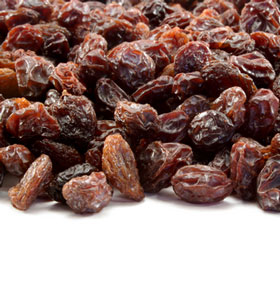Raisins
 |
|
Raisins are high in fructose, a naturally efficient fuel that carries a big punch in a little package. |
Because raisins are dehydrated grapes, their sugar concentration is very high. They make a terrific quick energy snack, and are also high in potassium (and calories).
The USDA pays very close attention to dried grapes. Government inspectors test each batch. The cleaning and packaging process is also tightly controlled.
History
In ancient times, raisins were used for everything from barter to remedies for growing old. They remained a secret of the Mediterranean region until about the 11th century when shipping methods improved. Four hundred years later, grapes were thriving in Mexico and California, which is now the third largest exporter following Turkey and Iran.
In an effort to foster ideal growing conditions, vineyards migrated up the coast, settling in the San Joaquin Valley. Today, it is the heart of California raisin territory.
Varieties
Choices are based on seedless variants of early grapes. Most California raisins are from the Thompson grape. When dried in the sun, they become dark. Golden raisins are dried in the oven and sulfur-treated.
The Black Corinth grape produces smaller Zante currants.
Raisins are labeled in three grades based on size: midget (small), select, and mixed.
You may find puffed Muscat raisins and “dried grape puffs” either at specialty stores or on-line retailers. Those that are grown from Muscat grapes contain seeds.
Other countries, including Australia, Chile, and Greece also produce grapes that are harvested exclusively for drying.
Buying Tips
If you plan to use raisins in breads and cookies, look for those labeled as “baking.” They are more moist and may be the “flame seedless” variety.





